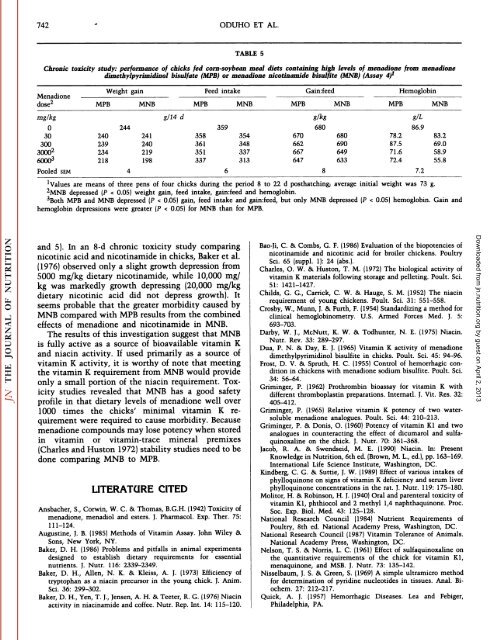Menadione Nicotinamide Bisulfite Is a Bîoactîve Source of ...
Menadione Nicotinamide Bisulfite Is a Bîoactîve Source of ...
Menadione Nicotinamide Bisulfite Is a Bîoactîve Source of ...
You also want an ePaper? Increase the reach of your titles
YUMPU automatically turns print PDFs into web optimized ePapers that Google loves.
742 ODUHO ET AL.<br />
TABLE 5<br />
Chronic toxicity study: performance <strong>of</strong> chicks fed corn-soybean meal diets containing high levels <strong>of</strong> menadione from menadione<br />
dimethylpyrimidinol bisulfate (MPB) or menadione nicotinamide bisulfite (MNB) (Assay 4)1<br />
<strong>Menadione</strong><br />
dose2mg/kg030300<br />
30002<br />
60003Pooled<br />
SEMWeight<br />
gainMPB240239234<br />
d244241240<br />
219<br />
218MNBg/14 1984Feed<br />
intakeMPB358361<br />
351<br />
337<br />
667647MNBS/kg680680690 649<br />
71.6 58.9<br />
337MNB359354348 3136Gain:feedMPB670662 6338HemoglobinMPB78.287.5 72.4MNBg/L86.983.269.0<br />
55.87.2<br />
'Values are means <strong>of</strong> three pens <strong>of</strong> four chicks during the period 8 to 22 d posthatching; average initial weight was 73 g.<br />
2MNB depressed (P < 0.05) weight gain, feed intake, gain:feed and hemoglobin.<br />
3Both MPB and MNB depressed [P < 0.05) gain, feed intake and gain:feed, but only MNB depressed (P < 0.05) hemoglobin. Gain and<br />
hemoglobin depressions were greater {P < 0.05) for MNB than for MPB.<br />
and 5). In an 8-d chronic toxicity study comparing<br />
nicotinic acid and nicotinamide in chicks, Baker et al.<br />
(1976) observed only a slight growth depression from<br />
5000 mg/kg dietary nicotinamide, while 10,000 mg/<br />
kg was markedly growth depressing (20,000 mg/kg<br />
dietary nicotinic acid did not depress growth). It<br />
seems probable that the greater morbidity caused by<br />
MNB compared with MPB results from the combined<br />
effects <strong>of</strong> menadione and nicotinamide in MNB.<br />
The results <strong>of</strong> this investigation suggest that MNB<br />
is fully active as a source <strong>of</strong> bioavailable vitamin K<br />
and niacin activity. If used primarily as a source <strong>of</strong><br />
vitamin K activity, it is worthy <strong>of</strong> note that meeting<br />
the vitamin K requirement from MNB would provide<br />
only a small portion <strong>of</strong> the niacin requirement. Tox<br />
icity studies revealed that MNB has a good safety<br />
pr<strong>of</strong>ile in that dietary levels <strong>of</strong> menadione well over<br />
1000 times the chicks' minimal vitamin K re<br />
quirement were required to cause morbidity. Because<br />
menadione compounds may lose potency when stored<br />
in vitamin or vitamin-trace mineral premixes<br />
(Charles and Huston 1972) stability studies need to be<br />
done comparing MNB to MPB.<br />
LITERATURE CITED<br />
Ansbacher, S., Corwin, W. C. & Thomas, B.G.H. (1942) Toxicity <strong>of</strong><br />
menadione, menadiol and esters. I. Pharmacol. Exp. Ther. 75:<br />
111-124.<br />
Augustine, J. B. (1985) Methods <strong>of</strong> Vitamin Assay. John Wiley &<br />
Sons, New York, NY.<br />
Baker, D. H. (1986) Problems and pitfalls in animal experiments<br />
designed to establish dietary requirements for essential<br />
nutrients. J. Nutr. 116: 2339-2349.<br />
Baker, D. H., Allen, N. K. & Kleiss, A. J. (1973) Efficiency <strong>of</strong><br />
tryptophan as a niacin precursor in the young chick. J. Anim.<br />
Sci. 36: 299-302.<br />
Baker, D. H., Yen, T. J., Jensen, A. H. & Teeter, R. G. (1976) Niacin<br />
activity in niacinamide and c<strong>of</strong>fee. Nutr. Rep. Int. 14: 115-120.<br />
Bao-Ji, C. &. Combs, G. F. (1986) Evaluation <strong>of</strong> the biopotencies <strong>of</strong><br />
nicotinamide and nicotinic acid for broiler chickens. Poultry<br />
Sci. 65 (suppl. 1): 24 (abs.).<br />
Charles, O. W. & Huston, T. M. (1972) The biological activity <strong>of</strong><br />
vitamin K materials following storage and pelleting. Poult. Sci.<br />
51: 1421-1427.<br />
Childs, G. G., Carrick, C. W. & Hauge, S. M. (1952) The niacin<br />
requirement <strong>of</strong> young chickens. Poult. Sci. 31: 551-558.<br />
Crosby, W., Munn, J. & Furth, F. (1954) Standardizing a method for<br />
clinical<br />
693-703.<br />
hemoglobinometry. U.S. Armed Forces Med. J. 5:<br />
Darby, W. J., McNutt, K. W. & Todhunter,<br />
Nutr. Rev. 33: 289-297.<br />
N. E. (1975) Niacin.<br />
Dua, P. N. & Day, E. J. (1965) Vitamin K activity<br />
dimethylpyrimidinol bisulfite in chicks. Poult.<br />
<strong>of</strong> menadione<br />
Sci. 45: 94-96.<br />
Frost, D. V. & Spruth, H. C. (1955) Control <strong>of</strong> hemorrhagic con<br />
dition in chickens<br />
34: 56-64.<br />
with menadione sodium bisulfite. Poult. Sci.<br />
Griminger, P. (1962) Prothrombin bioassay for vitamin K with<br />
different<br />
405-412.<br />
thromboplastin preparations. Internati. J. Vit. Res. 32:<br />
Griminger, P. (1965) Relative vitamin K potency <strong>of</strong> two watersoluble<br />
menadione analogues. Poult. Sci. 44: 210-213.<br />
Griminger, P. & Donis, O. (1960) Potency <strong>of</strong> vitamin Kl and two<br />
analogues in counteracting the effect <strong>of</strong> dicumarol and sulfaquinoxaline<br />
on the chick. J. Nutr. 70: 361-368.<br />
Jacob, R. A. &. Swendseid, M. E. (1990) Niacin. In: Present<br />
Knowledge in Nutrition, 6th ed. (Brown, M. L., éd.), pp. 163-169.<br />
International Life Science Institute, Washington, DC.<br />
Kindberg, C. G. & Suttie, J. W. (1989) Effect <strong>of</strong> various intakes <strong>of</strong><br />
phylloquinone<br />
phylloquinone<br />
on signs <strong>of</strong> vitamin K deficiency and serum liver<br />
concentrations in the rat. J. Nutr. 119: 175-180.<br />
Molitor, H. &. Robinson, H. J. (1940) Oral and parenteral toxicity <strong>of</strong><br />
vitamin Kl, phthiocol and 2 methyl<br />
Soc. Exp. Biol. Med. 43: 125-128.<br />
1,4 naphthaquinone. Proc.<br />
National Research Council (1984) Nutrient Requirements <strong>of</strong><br />
Poultry, 8th ed. National Academy Press, Washington, DC.<br />
National Research Council (1987) Vitamin Tolerance <strong>of</strong> Animals.<br />
National Academy Press, Washington, DC.<br />
Nelson, T. S. & Norris, L. C. (1961) Effect <strong>of</strong> sulfaquinoxaline on<br />
the quantitative requirements <strong>of</strong> the chick for vitamin<br />
menaquinone, and MSB. J. Nutr. 73: 135-142.<br />
Kl,<br />
Nisselbaum, }. S. & Green, S. (1969) A simple ultramicro method<br />
for determination <strong>of</strong> pyridine nucleotides in tissues. Anal. Biochem.<br />
27: 212-217.<br />
Quick, A. f. (1957) Hemorrhagic Diseases. Lea and Febiger,<br />
Philadelphia, PA.<br />
Downloaded from<br />
jn.nutrition.org<br />
by guest on April 2, 2013
















